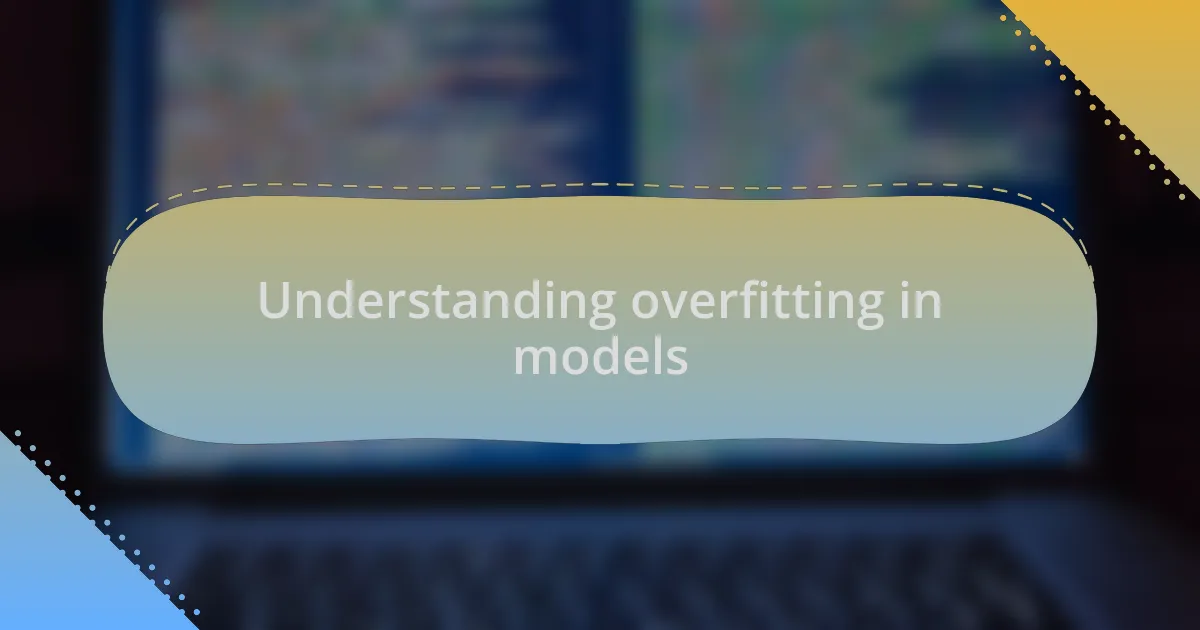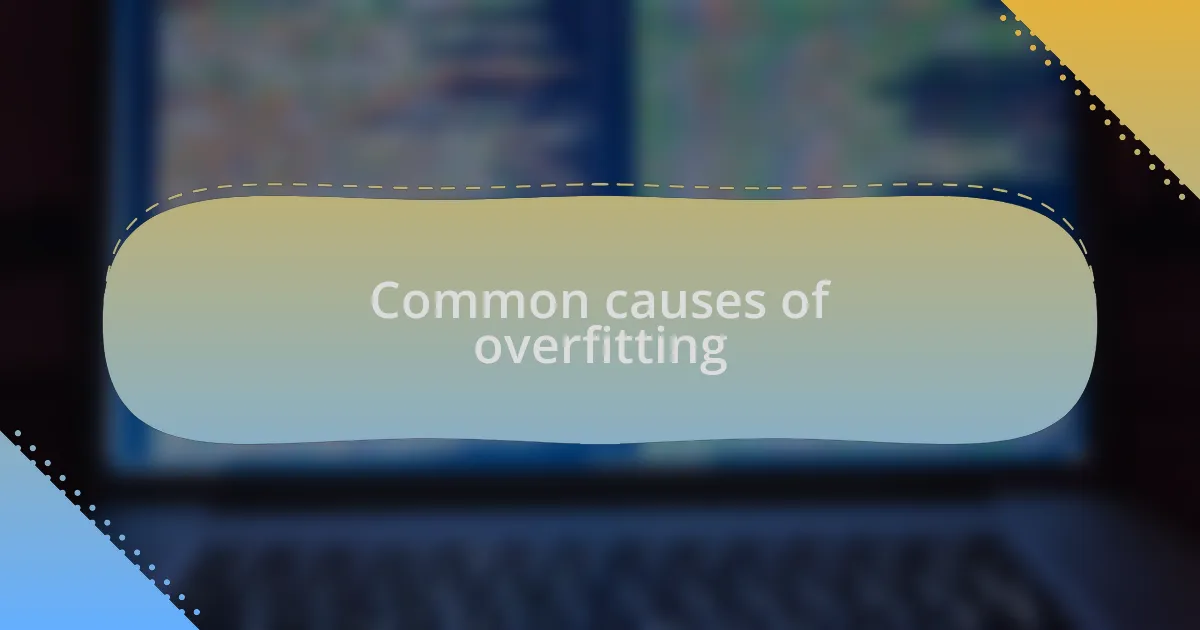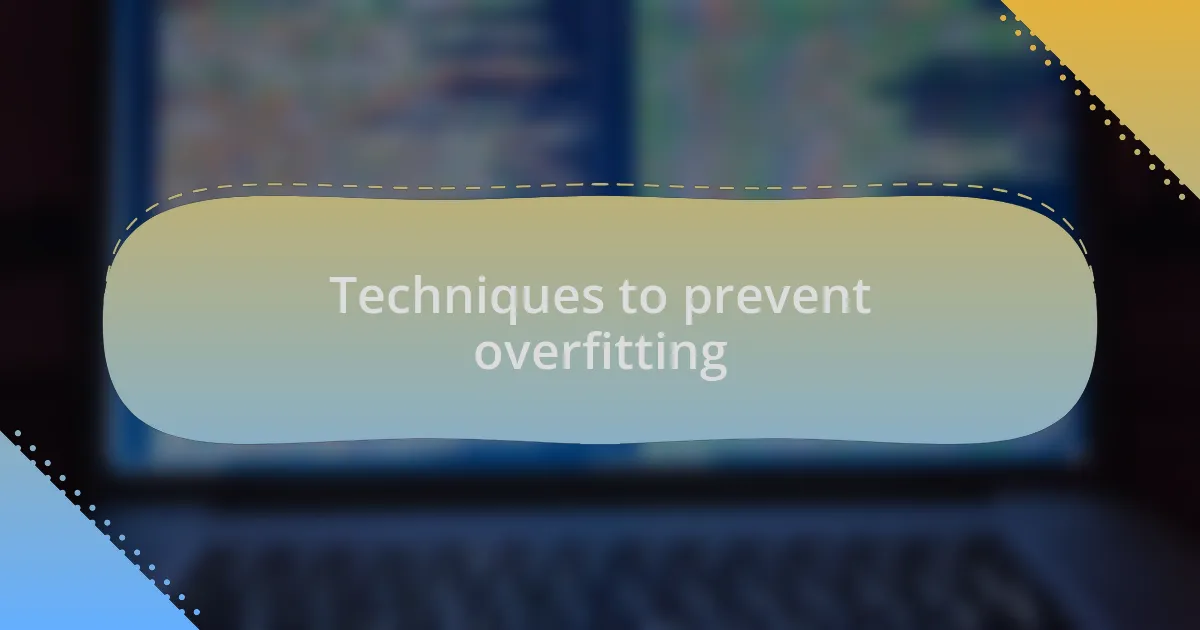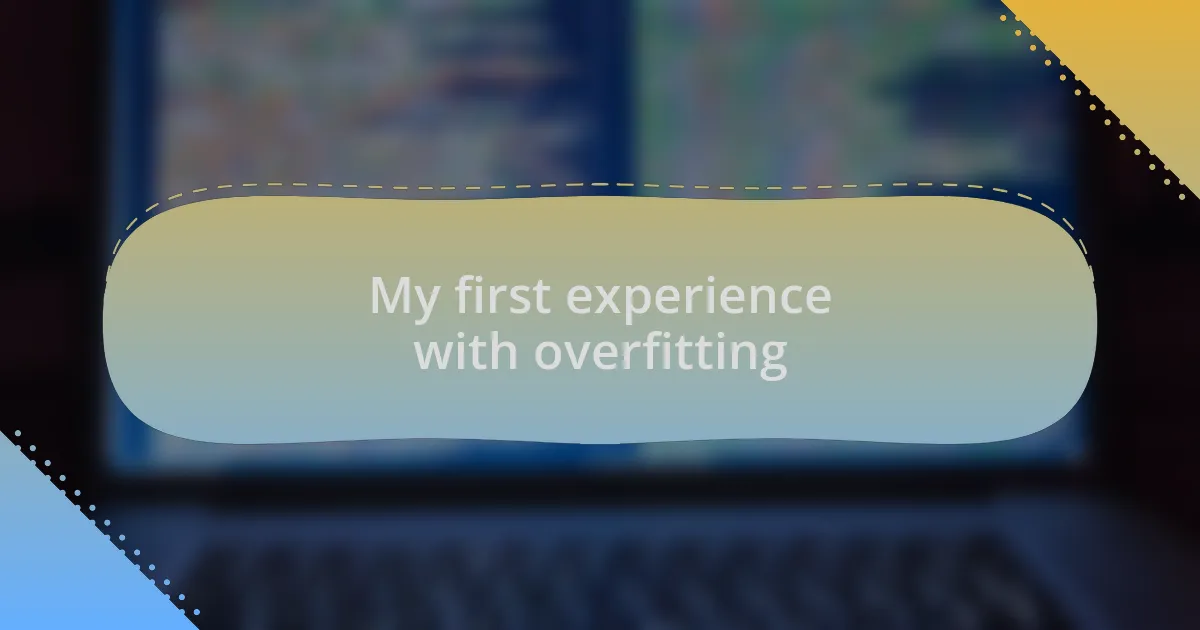Key takeaways:
- Overfitting hinders a model’s generalization ability, leading to strong performance on training data but poor results on unseen data.
- Model evaluation is crucial for understanding performance and requires selecting appropriate metrics tailored to specific problems.
- Simplicity in model design can improve generalization, and techniques like cross-validation help prevent overfitting by assessing model robustness.
- Embracing the iterative nature of model development transforms failures into valuable learning experiences, fostering continuous improvement.

Understanding overfitting in models
Overfitting occurs when a model learns the details and noise in the training data to the extent that it negatively impacts its performance on new data. I remember when I first encountered overfitting while developing a predictive model; I was amazed at how well it performed on the training set but was disheartened to see it flop during testing. It struck me then that a model’s ability to generalize is far more crucial than merely scoring high on familiar datasets.
The signs of overfitting can often be subtle yet profound. Have you ever felt a sense of frustration when your model performs beautifully on validation data but struggles in real-world applications? It’s a classic trap that many of us fall into, leading to the illusion of success while overlooking the importance of adaptability and robustness in our models.
One of the most striking aspects of overfitting is how it reveals the balance between complexity and simplicity. On a personal note, I recall a time when I fought against the urge to make my model more complex, thinking it would yield better results. It was a learning curve—realizing that simplifying my model actually led to higher accuracy when evaluating new, unseen data. This experience taught me that sometimes, less truly is more.

Importance of model evaluation
Model evaluation is essential as it provides a clear understanding of how well a model will perform on unseen data. I vividly remember completing a project only to realize that my final model was overfitting, as I had not properly evaluated its performance. Reflecting on that, I’ve come to appreciate that evaluations are not just numbers; they tell a story about the model’s predictive capabilities.
When I think about the different metrics we can use for evaluation—like accuracy, precision, and recall—I sometimes get overwhelmed. Have you ever faced that dilemma? It’s crucial to choose the right metric based on the specific problem at hand. For instance, in a project focused on detecting rare diseases, I found that relying solely on accuracy was misleading. Instead, emphasizing precision helped me better understand my model’s ability to identify true positives.
Additionally, model evaluation helps me identify when adjustments are necessary. I’ve had my share of moments where I believed my model was flawless, only to find that further fine-tuning could enhance its performance. I encourage you to view evaluation as an ongoing dialogue—a means to keep evolving and improving your model rather than a final destination. Each evaluation round is a step towards a more robust solution.

Common causes of overfitting
Overfitting often creeps in when a model learns too much from the training data, including noise and outliers. I recall a project where I used a complex model with numerous features, thinking it would capture every nuance. Instead, I ended up with a model that performed beautifully on the training set but flopped when it faced real-world data. It was a tough lesson, but it made me realize that simpler models often generalize better.
Another common cause of overfitting is insufficient training data. Early in my journey, I tried to build a predictive model with a limited dataset, hoping it would be robust. As it turns out, that lack of diversity led the model to memorize the few examples it had instead of learning patterns. Does that resonate with you? It’s a reminder that the data we use isn’t just a feed; it’s the foundation on which our predictions stand.
Lastly, I often find that overly complex models contribute to this issue. The allure of sophisticated algorithms can be tempting, but I’ve learned that complexity doesn’t always equal performance. I remember exploring ensemble techniques, thinking they would automatically improve my results. However, integrating too many layers calculated risks, and I found my models were capturing noise rather than signals. It’s a cautionary tale that emphasizes the importance of striking a balance between model complexity and interpretability.

Techniques to prevent overfitting
One technique I’ve found effective in preventing overfitting is to use cross-validation. Early on, I remember setting aside a portion of my dataset to validate my model’s performance. This wasn’t just an exercise; it felt like a reality check. By analyzing how my model performed on unseen data, I could adjust its parameters confidently, ensuring it generalized well rather than just memorized the training set.
Another approach I’ve experimented with is feature selection. In one of my projects, I initially included every feature at my disposal, thinking they might contribute to the model’s accuracy. However, I quickly realized that this was a recipe for disaster. Reducing the number of features not only simplified my model but also enhanced its ability to make predictions on new data. It’s funny how less can sometimes mean more, isn’t it?
Lastly, regularization techniques have become a go-to strategy for me. When I first encountered Lasso and Ridge regression, I was intrigued but skeptical. The idea that I could penalize complex models to help them focus on the most important features was a revelation. I remember applying Lasso regression to my models and watching as it effectively trimmed the fat—removing unnecessary complexity while improving overall performance. It was like giving my model a well-deserved diet, leading to a more robust and reliable output.

My first experience with overfitting
I still vividly remember my first encounter with overfitting—it was almost like a rite of passage in my journey as a data scientist. I had trained a neural network on a relatively small dataset, and the accuracy on my training set was through the roof. However, when it came time for evaluation, the performance plummeted, leaving me frustrated and bewildered. How could a model perform so well on training data, yet fail so spectacularly on unseen data?
In that moment of despair, I decided to dig deeper into the concept of overfitting. I recall the feeling of clarity when I learned about the importance of a balanced dataset. Realizing I had let my model memorize patterns rather than learning to generalize was a tough pill to swallow. It felt like I had taken a wrong turn on a road trip and had to backtrack, but ultimately, it taught me a crucial lesson in modeling: sometimes, you have to take a step back to move forward.
What struck me most was the emotional rollercoaster that accompanied battling overfitting. Each failed model was disheartening, yet it motivated me to refine my techniques and understanding. The combination of frustration and curiosity ignited a passion within me to explore, leading me to experiment with regularization techniques and feature selections. This journey not only enhanced my skills but also deepened my appreciation for the art and science behind building predictive models.

Lessons learned from my journey
As I navigated my way through the challenges of overfitting, one pivotal lesson was the need for simplicity in model design. I vividly remember a time when I tried to create an intricate model with several layers and millions of parameters, only to end up with a complex beast that performed poorly on new data. It was a wake-up call: sometimes, a simpler model can yield better results when it comes to generalization. Do you know that feeling when you’ve overcomplicated something and suddenly realize a straightforward approach could have saved you heartache?
Another critical insight emerged during my experimentation with cross-validation techniques. The first time I applied k-fold cross-validation, I experienced a wave of relief when I saw consistent performance across folds. It was enlightening to know that dividing my data into training and testing sets multiple times not only built my confidence but also provided me with a clearer picture of how my model would truly perform in the wild. Every iteration made me appreciate how this method acted like a safety net—catching potential pitfalls before they could trip me up.
Lastly, I learned to embrace the iterative nature of model development. In the beginning, I would often view each model’s failure as a setback rather than a stepping stone. But then came a realization: every misstep was a lesson in disguise, pushing me toward improvement. Each time I revisited my models with newfound knowledge, I couldn’t help but feel a sense of excitement. Have you ever felt invigorated by an unexpected breakthrough after tinkering with something that didn’t work at first? That sense of discovery is what makes this journey so thrilling.